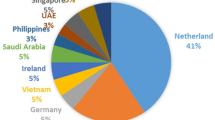Abstract
Instrumental neutron activation analysis (INAA) and protoninduced X-ray emission (PIXE) analysis have been employed to determine the concentration of 13 elements in human breast milk, various infant formulas, and locally produced cereals from Nigeria, as well as from various infant formulas and natural cow and goat milk available in the UK. The study shows that if the locally produced cereal is to be used on a regular basis for babies in Nigeria, then their diet must be supplemented with essential trace elements. Furthermore, parents should be discouraged from giving their infants cow and goat milk because of the high concentration of major elements compared to human breast milk.
Similar content being viewed by others
References
Canadian Paediatric Society and American Academy of Pediatrics, Committes on Nutrition,Pediatrics 62, 591–601 (1978).
Great Britain Department of Health and Social Security, Report on Health and Social Subjects No 9, HMSO, London, 1974.
International Pediatric Association,Acta Paediatr. Scand. 65, 275–277 (1977).
Twenty-Seventh World Health Assembly, WHO Official Record No. 217, 1978.
B. Lonnerdal, C. L. Keen, M. Ohtake, and T. Tamura,Am. J. Dis. Child. 137, 433–437 (1983).
J. J. Bullen, H. J. Roger, and L. Leigh,Br. Med. J. 1, 69–75 (1972).
A. S. Cunningham,J. Pediatr. 95, 685–689 (1979).
M. E. Fallot, J. L. Boyd, and F. A. Oski,Pediatr. 65, 1121–1124 (1980).
K. Bostrom, inTextbook of Paediatric Nutrition, R. M. Suskind, ed., Raven, New York, 1981, pp. 41–64.
T. Morishima, S. Yagi, and T. Takamura, inTrace Element Metabolism in Man and Animal, J. M. Howell, J. M. Gawthorne and C. L. White, eds., Griffin Press, Netley, South Australia, 1981, pp. 487–490.
A. Flynn, inAdvances in Food and Nutrition Research, vol 36, Academic, San Diego, California, 1992, pp. 209–252.
S. J. Fomon and R. G. Strauss,N. Engl. J. Med. 299, 355–357 (1978).
Author information
Authors and Affiliations
Rights and permissions
About this article
Cite this article
Balogun, F.A., Akanle, O.A., Spyrou, N.M. et al. A comparative study of elemental composition of human breast milk and infant milk substitutes. Biol Trace Elem Res 43, 471–479 (1994). https://doi.org/10.1007/BF02917349
Issue Date:
DOI: https://doi.org/10.1007/BF02917349




